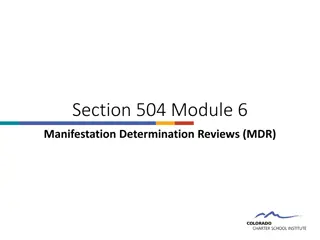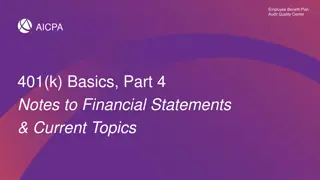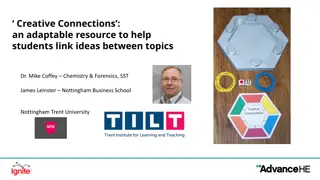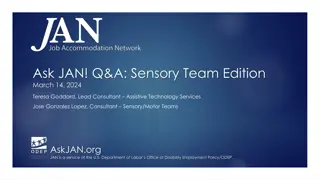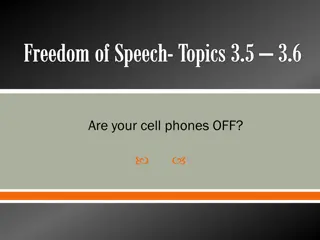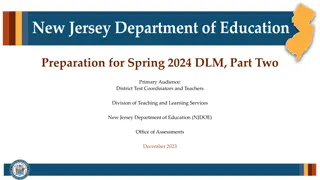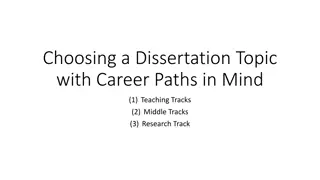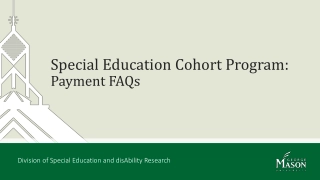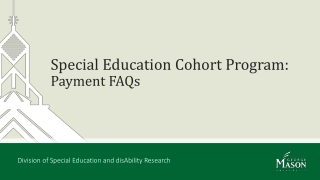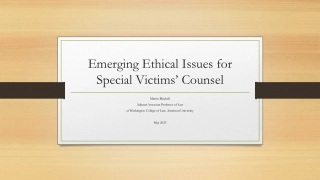CS 404/504 Special Topics
Adversarial machine learning techniques in text and audio data involve generating manipulated samples to mislead models. Text attacks often involve word replacements or additions to alter the meaning while maintaining human readability. Various strategies are used to create adversarial text examples, making it more challenging than image data. Text processing models have evolved over the years, from rule-based approaches to advanced transformer models like BERT and GPT.
Download Presentation
Please find below an Image/Link to download the presentation.
The content on the website is provided AS IS for your information and personal use only. It may not be sold, licensed, or shared on other websites without obtaining consent from the author. Download presentation by click this link. If you encounter any issues during the download, it is possible that the publisher has removed the file from their server.
Presentation Transcript
CS 404/504 CS 404/504 Special Topics: Special Topics: Adversarial Adversarial Machine Learning Machine Learning Dr. Alex Vakanski
CS 404/504, Spring 2023 Lecture 14 Lecture 14 Adversarial Examples in Text and Audio Data 2
CS 404/504, Spring 2023 Lecture Outline Adversarial examples in text data Attacks on text classification models Ebrahimi (2018) HotFlip attack Gao (2018) DeepWordBug attack Attacks on reading comprehension models Jia (2017) Text concatenation attack Attacks on translation and text summarization models Cheng (2018) Seq2Sick attack Attacks on dialog generation models He (2018) Egregious output attack Attacks against transformer language models Jin (2020) TextFooler Guo (2021) GBDA attack Jiang Chang presentation Adversarial examples in audio data: Carlini (2018) Targeted attacks on speech-to-text 3
CS 404/504, Spring 2023 Adversarial Examples in Text Data Adversarial Examples in Text Data Adversarial examples were shown to exists for ML models for processing text data An adversary can generate manipulated text sentences that mislead ML text models To satisfy the definitions for adversarial examples, a generated text sample x that is obtained by perturbing a clean text sample xshould look similar to the original text The perturbed text should preserve the semantic meaning for a human reader I.e., an adversarial text sample that is misclassified by an ML model should not be misclassified by a typical human In general, crafting adversarial examples in text data is more challenging than in image data E.g., many text attacks output grammatically or semantically incorrect sentences Generation of adversarial text examples is often based on replacement of input words (with synonyms, misspelled words, or words with similar vector embeddings), or based on adding distracting text to the original clean text 4
CS 404/504, Spring 2023 Text Processing Models Adversarial Examples in Text Data Dominant text processing models Pre 1990 o Hand-crafted rule-based approaches (if-then-else rules) 1990-2014 o Traditional ML models, e.g., decision trees, logistic regression, Na ve Bayes 2014-2018 o Recurrent NNs (e.g., LSTM, GRU) layers o Combinations of CNNs and RNNs o Bi-directional LSTM layers 2018-present time o Transformers (BERT, RoBERTa, GPT family, Bard, LLaMA) 5 Slide credit: Chollet (2021) Deep Learning with Python
CS 404/504, Spring 2023 Adversarial Examples in Text versus Images Adversarial Examples in Text Data Image data Inputs: pixel intensities Continuous inputs Adversarial examples can be created by applying small perturbations to pixel intensities o Adding small perturbations does not change the context of the image o Gradient information can be used to perturb the input images Metrics based on ? norms can be applied for measuring the distance to adversarial examples Text data Inputs: words or characters Discrete inputs Small text modifications are more difficult to apply to text data for creating adversarial examples o Adding small perturbations to words can change the meaning of the text o Gradient information cannot be used, generating adversarial examples requires applying heuristic approaches (e.g., word replacement with local search) to produce valid text It is more difficult to define metrics for measuring text difference, ? norms cannot be applied 6
CS 404/504, Spring 2023 Ebrahimi (2018) HotFlip Attack Attacks on Text Classification Models Ebrahimi et al. (2018) HotFlip: White-Box Adversarial Examples for Text Classification HotFlip attacks character-level text classifiers by replacing one letter in text It is a white-box untargeted attack Approach: o Use the model gradient to identify the most important letter in the text o Perform an optimization search to find a substitute (flip) for that letter The approach also supports insertion or deletion of letters In this example, the predicted topic label of the sentence is changed from World to Sci/Tech by changing the letter P in the word mood Original text Predicted class Adversarial text Predicted class 7
CS 404/504, Spring 2023 Ebrahimi (2018) HotFlip Attack Attacks on Text Classification Models Attacked model: CharCNN-LSTM, a character-level model that uses a combination of CNN and LSTM layers Dataset: AG news dataset, consists of 120K training and 7.6K testing instances with 4 classes: World, Sports, Business, and Science/Technology The attack does not change the meaning of the text, and it is often unnoticed by human readers Original text Predicted class Adversarial text Predicted class 8
CS 404/504, Spring 2023 Gao (2018) DeepWordBug Attack Attacks on Text Classification Models Gao et al. (2018) Black-box Generation of Adversarial Text Sequences to Evade Deep Learning Classifiers DeepWordBug attack is a black-box attack on text classification models The approach has similarity to the HotFlip attack: Identify the most important tokens (either words or characters) in a text sample Apply character-level transformations to change the label of the text Key idea: the misspelled words in the adversarial examples are considered unknown words by the ML model Changing the important words to unknown impacts the prediction by the model Applications: the attack was implemented against three different models, which include text classification, sentiment analysis, spam detection Attacked models: Word-LSTM (uses word tokens) and Char-CNN (uses character tokens) models Datasets: evaluated on 8 text datasets 9
CS 404/504, Spring 2023 Gao (2018) DeepWordBug Attack Attacks on Text Classification Models Example of a generated adversarial text for sentiment analysis The original text sample has a positive review sentiment An adversarial sample is generated by changing 2 characters, resulting in wrong classification (negative review sentiment) Question: is the adversarial sample perceptible to a human reader? Argument: a human reader can understand the meaning of the perturbed sample, and assign positive review sentiment 10
CS 404/504, Spring 2023 Gao (2018) DeepWordBug Attack Attacks on Text Classification Models Attack approach Assume an input sequence x = ?1?2?3 ??, and ?(x) is output of a black-box model The authors designed 4 scoring functions to identify the most important tokens o Replace-1 score: evaluate the output ?(x) when the token ??is replaced with the unknown (i.e., out of vocabulary) token ?? ?1? ?? = ? ?1,?2, ?? 1,??, ?? ? ?1,?2, ?? 1,?? , ?? o Temporal head score: evaluate the output of the model for the tokens before ?? ??? ?? = ? ?1,?2, ?? 1,?? ? ?1,?2, ?? 1 o Temporal tail score: evaluate the output of the model for the tokens after ?? ??? ?? = ? ??,??+1, ,?? ? ??+1, ?? o Combined score: a weighted sum of the Temporal Head and Temporal Tail Scores ?? ?? = ??? ?? + ???? ?? 11
CS 404/504, Spring 2023 Gao (2018) DeepWordBug Attack Attacks on Text Classification Models Attack approach Next, the top m important tokens selected by the scoring functions are perturbed The following 4 transformations are considered: o Swap swap two adjacent letters o Substitution substitute a letter with a random letter o Deletion delete a letter o Insertion insert a letter Edit distance of the perturbation is the minimal number of edit operations to change the original text o The edit distance is 2 edits for the swap transformation, and 1 edit for substitution, deletion, and insertion transformations 12
CS 404/504, Spring 2023 Gao (2018) DeepWordBug Attack Attacks on Text Classification Models Datasets details 13
CS 404/504, Spring 2023 Gao (2018) DeepWordBug Attack Attacks on Text Classification Models Evaluation results for attacks against Word-LSTM and Char-CNN models The maximum edit distance is set to 30 characters Left figure: DeepWordBug reduced the performance by the Word-LSTM model by 68.05% in comparison to the accuracy on non-perturbed text samples o Temporal Tail score function achieved the largest decrease in accuracy Right figure: decrease in the accuracy by the Char-CNN of 48.58% was achieved Char-CNN model Word-LSTM model 14
CS 404/504, Spring 2023 Gao (2018) DeepWordBug Attack Attacks on Text Classification Models Evaluation results on all 8 datasets for the Word-LSTM model Two baseline approaches are included for comparison (Random token replacement and Gradient) The largest average decrease in the performance was achieved by the Temporal Tail scoring function approach (mean decrease of 68.05% across all datasets) 15
CS 404/504, Spring 2023 Gao (2018) DeepWordBug Attack Attacks on Text Classification Models Are adversarial text examples transferable across ML models? Yes! The figure shows the accuracy on adversarial examples generated with one model and transferred to other models Four models were considered containing LSTM and bi-directional LSTM layers (BiLSTM) The adversarial examples transferred successfully to other models 16
CS 404/504, Spring 2023 Gao (2018) DeepWordBug Attack Attacks on Text Classification Models Evaluation of adversarial training defense The figure shows the standard accuracy on regular text samples (blue), and the adversarial accuracy (orange) on adversarial samples for 10 epochs The adversarial accuracy improves significantly to reach 62.7%, with a small trade-off in the standard accuracy 17
CS 404/504, Spring 2023 Jia (2017) Text Concatenation Attack Attacks on Reading Comprehension Models Jia et al. (2017) Adversarial Examples for Evaluating Reading Comprehension Systems Reading comprehension task An ML model answers questions about paragraphs of text Human performance was measured at 91.2% accuracy Text Concatenation Attack is a black-box, non-targeted attack Adds additional sequences to text samples to distract ML models The generated adversarial examples should not confuse humans Attacked model: LSTM-based model for reading comprehension Dataset: Stanford Question Answering Dataset (SQuAD) Consists of 108K human-generated reading comprehension questions about Wikipedia articles Results: accuracy decreased from 75% to 36% 18
CS 404/504, Spring 2023 Jia (2017) Text Concatenation Attack Attacks on Reading Comprehension Models Example The concatenated adversarial text in blue color at the end of the paragraph fooled the ML model to give the wrong answer Jeff Dean 19
CS 404/504, Spring 2023 Jia (2017) Text Concatenation Attack Attacks on Reading Comprehension Models ADDSENT approach uses a four-step procedure to add a sentence to a text Step 1 changes words in the question with nearest words in the embedding space, Step 2 generates a fake answer randomly, and Step 3 replaces the changed words Step 4 involves human-in-the-loop to fix grammar errors or unnatural sentences Attack Original text and prediction 20
CS 404/504, Spring 2023 Cheng (2018) Seq2Sick Attack Attacks on Translation and Text Summarization Models Cheng et al. (2018) Seq2Sick: Evaluating the Robustness of Sequence-to-Sequence Models with Adversarial Examples Seq2Sick is a white-box, targeted attack Attacked are RNN-based sequence-to-sequence (seq2seq) models, used for machine translation and text summarization tasks Seq2seq models are more challenging to attack than classification models, because there are infinite possibilities for the text sequences outputted by the model o Conversely, classification models have a finite number of output classes o Example: Input sequence in English: Output sequence in German: A child is splashing in the water. Ein kind im wasser. Attacked model: word-level LSTM encoder-decoder This work designed a regularized PGD method to generate adversarial text examples with targeted outputs 21
CS 404/504, Spring 2023 Cheng (2018) Seq2Sick Attack Attacks on Translation and Text Summarization Models Text summarization example with a target keyword police arrest Original text: President Boris Yeltsin stayed home Tuesday, nursing a respiratory infection that forced him to cut short a foreign trip and revived concerns about his ability to govern. Summary by the model: Yeltsin stays home after illness. Adversarial example: President Boris Yeltsin stayed home Tuesday, cops cops respiratory infection that forced him to cut short a foreign trip and revived concerns about his ability to govern. Summary by the model: Yeltsin stays home after police arrest. 22
CS 404/504, Spring 2023 Cheng (2018) Seq2Sick Attack Attacks on Translation and Text Summarization Models Other text summarization examples with a target keyword police arrest 23
CS 404/504, Spring 2023 Cheng (2018) Seq2Sick Attack Attacks on Translation and Text Summarization Models Text summarization examples with a non-overlapping attack I.e., the output sequence does not have overlapping words with the original output 24
CS 404/504, Spring 2023 Cheng (2018) Seq2Sick Attack Attacks on Translation and Text Summarization Models Seq2Sick approach For an input sequence ? and perturbation ?, solve the optimization problem formulated as min ? ? + ? + ?1 ??+ ?2 min ?? ??+ ?? ?? ? ? The first term ? + ? is a loss function that is minimized by using Projected Gradient Descent (PGD) The second and third term are regularization terms The term ??? applies lasso regularization to ensure that only a few words in the text sequence are changed The third term ?min ??+ ?? ?? applies gradient regularization to ensure that the ?? perturbed input words ??+ ?? are close in the word embedding space to existing words ?? from a vocabulary W 25
CS 404/504, Spring 2023 Cheng (2018) Seq2Sick Attack Attacks on Translation and Text Summarization Models Datasets: Text summarization: Gigaword, DUC2003, DUC2004 Machine translation: German-English WMT 15 dataset Evaluation results |K| is the number of targeted keywords #changed is number of changed words Success rate of the attack is over 99% for 1 targeted keyword BLEU score stands for Bilingual Evaluation Understudy, and evaluates the quality of text translated from one language to another o BLEU scores between 0 and 1 are assigned based on a comparison of machine translations to good quality translations created by humans o High BLEU score means good quality text Text Summarization - Targeted Keywords 26
CS 404/504, Spring 2023 Cheng (2018) Seq2Sick Attack Attacks on Translation and Text Summarization Models Evaluation results for text summarization using non-overlapping words High BLEU score for text summarization indicates that the adversarial examples are similar to the clean input samples Despite that the attacks is quite challenging, high success rates were achieved Evaluation results for machine translation Results for non-overlapping words and targeted keywords are presented Text Summarization Non-overlapping Words Machine Translation 27
CS 404/504, Spring 2023 He (2018) Egregious Output Attack Attacks on Dialog Generation Models He (2018) Detecting Egregious Responses in Neural Sequence-to-sequence Models Egregious output attack: attack on RNN seq2seq models for dialog generation Research question: can ML models for dialog generation (e.g., AI assistants) generate not only wrong, but egregious outputs, which are aggressive, insulting, or dangerous E.g., you ask your AI assistant a question and it replies: You are so stupid, I don t want to help you Attacked model: LSTM encoder-decoder Approach: Create manually a list of malicious sentences that shouldn t be output by ML models Developed an optimization algorithm to search for trigger inputs that maximize the probability of generating text that belongs to the list of malicious sentences Results: the authors discovered input text samples that can generate egregious outputs 28
CS 404/504, Spring 2023 He (2018) Egregious Output Attack Attacks on Dialog Generation Models Datasets Ubuntu conversational data: an agent is helping a user to deal with issues Switchboard dialog dataset: two-sided telephone conversations OpenSubtitles: dataset of movie subtitles Table: trigger inputs that result in target egregious outputs 29
CS 404/504, Spring 2023 Jin (2020) TextFooler Attacks against Transformer Language Models Jin (2020) Is BERT Really Robust? A Strong Baseline for Natural Language Attack on Text Classification and Entailment TextFooler attack is a black-box attack on transformers, CNN, and RNN language models The adversarial examples are transferrable to the other models Approach: Identify most important words and replace them with synonyms Attacked models: BERT (transformer model), WordCNN, and WordRNN for text classification (sentiment analysis) 30
CS 404/504, Spring 2023 Jin (2020) TextFooler Attacks against Transformer Language Models Attack approach: Step 1: for each word, compute an importance score o Remove that word and query the back-box model to obtain a prediction score/label Important words cause large change in the predicted score Step 2: sort the words in descending order based on their importance Step 3: for each word identify a set of candidate replacement words o Find the top N closest synonyms in the vocabulary Use cosine similarity in the embeddings space as a metric for identifying the closest synonyms o Keep only the synonyms that have the same part-of-speech tag (i.e., if the word is a verb, consider only verb synonyms) Step 4: replace a word with a synonym and check the semantic similarity of the new sentence o Use Universal Sentence Encoder (USE) to encode the original text and the adversarial sample into embedding vectors o Next, apply cosine similarity between the embeddings of the original text and the adversarial sample to check whether they are semantically similar Step 5: choose the words with greatest semantic similarity that alter the predicted score 31
CS 404/504, Spring 2023 Jin (2020) TextFooler Attacks against Transformer Language Models Generated adversarial examples The word Perfect in the original text is replaced with the word Spotless The model prediction was changed from positive sentiment (99% confidence) to negative (100%) By replacing the words contrived situations and totally the predicted sentiment was changed from negative to positive 32
CS 404/504, Spring 2023 Jin (2020) TextFooler Attacks against Transformer Language Models The attack was validated with three models: WordCNN, WordLSTM, and BERT Five datasets: MR (Movie Reviews), IMDB (movie reviews), Yelp (reviews), AG (news classification), and Fake (fake news detection) The classification accuracy was reduced to less than 20% for all models The number of perturbed words ranged from 3% to 22% of the text 33
CS 404/504, Spring 2023 Guo (2021) GBDA Attack Attacks against Transformer Language Models Guo et al. (2021) Gradient-based Adversarial Attacks against Text Transformers Gradient-based Distributional Adversarial (GBDA) attack is a white-box attack on transformer language models The adversarial examples are also be transferrable in black-box setting Approach: Define an output adversarial distribution, which enables using the gradient information Introduce constraints to ensure semantic correctness and fluency of the perturbed text Attacked models: GPT-2, XLM, BERT GBDS attack was applied to text classification and sentiment analysis tasks Runtime: approximately 20 seconds per generated example 34
CS 404/504, Spring 2023 Guo (2021) GBDA Attack Attacks against Transformer Language Models Generated adversarial examples for text classification The changes in input text are subtle: o worry hell , camel animal , no varying o Adversarial text examples preserved the semantic meaning of the original text 35
CS 404/504, Spring 2023 Guo (2021) GBDA Attack Attacks against Transformer Language Models The discrete inputs in text prevent from using gradient information for generating adversarial samples This work introduces models that take probability vectors as inputs, to derive smooth estimates of the gradient Specifically, transformer models take as input a sequence of embedding vectors corresponding to text tokens, e.g., ? = ?1?2?3 ?? GBDA attack considered an input sequence consisting of probability vectors corresponding to the text tokens, e.g., ?(?) = ? ?1? ?2?(?3) ?(??) Gumbel-softmax distribution provides a differentiable approximation to sampling discrete inputs This allows to use gradient descent for estimating the loss with respect to the probability distribution of the inputs The work applied additional constraints to enforce semantic similarity and fluency of the perturbed samples 36
CS 404/504, Spring 2023 Guo (2021) GBDA Attack Attacks against Transformer Language Models Evaluation results For the three models (GPT-2, XML, and BERT) on all datasets, adversarial accuracy of less than 10% was achieved Cosine similarity was employed to evaluate the semantic similarity of perturbed samples to the original clean samples o All attacks indicate high semantic similarity 37
CS 404/504, Spring 2023 Guo (2021) GBDA Attack Attacks against Transformer Language Models Evaluation of transferability of the generated adversarial samples Perturbed text samples from GPT-2 are successfully transferred to three other transformer models: ALBERT, RoBERTa, and XLNet 38
CS 404/504, Spring 2023 References Xu et al. (2019) Adversarial Attacks and Defenses in Images, Graphs and Text: A Review (link) Francois Chollet (2021) Deep Learning with Python, Second Edition 1. 2. 39
AUDIO ADVERSARIAL EXAMPLES: TARGETED ATTACKS ON SPEECH-TO-TEXT Supervisor: Dr. Alex Vakanski Presenter: Jiang Chang
OUTLINE BACKGROUND METHOD RESULT AND ANALYSIS CONCLUSION
BACKGROUND BACKGROUND
BACKGROUND - 43 - Image Source: https://developer.nvidia.com/blog/how-to-build-domain-specific-automatic-speech-recognition-models-on-gpus/
BACKGROUND - 44 Ref: https://adversarial-attacks.net/ -
METHOD METHOD
METHOD - 46 -
MFCC (MEL-FREQUENCY CEPSTRAL COEFFICIENTS) CHARACTERISTIC VECTORS EXTRACTION FLOW - 47 - Ref: Tsai, Wen-Chung & Shih, You-Jyun & Huang, Nien-Ting. (2019). Hardware-Accelerated, Short-Term Processing Voice and Nonvoice Sound Recognitions for Electric Equipment Control. Electronics. 8. 924. 10.3390/electronics8090924.
CONNECTIONIST TEMPORAL CLASSIFICATION (CTC) LOSS - 49 - Image source: https://paperswithcode.com/method/ctc-loss
DECODING METHODS Beam search algorithm Greedy search algorithm - 50 - Ref: https://medium.com/@jessica_lopez/understanding-greedy-search-and-beam-search-98c1e3cd821d


